
Episode: Mythbusters 8.23 – “MiniMyth Madness”
Original Air Date: November 10, 2010
Is James Bond really so good that he could swim to a black tie party wearing his tuxedo under his wetsuit and mingle with the crowd with no one the wiser? Can a laptop, a hair weave, or a refrigerator door stop a bullet? Is it really that easy to take candy from a baby? This week, the Mythbusters picked six fan-submitted myths that they could test quickly and packed them all into a single episode. It made for lots of excitement, a few surprises, and three times the usual number of confirmed/plausible/busted pronouncements! If you haven’t seen it yet, you might want to stop here or else risk even more spoilers than usual.
Mini-Myth #1: It is possible for a secret agent to swim underwater to a party on a boat where he takes off his diving gear to reveal a perfectly dry and party-ready tuxedo underneath.
Mythbusters: Adam and Jamie
Procedure:
- Get two tuxedos and ask a fashion expert to give tips on proper tuxedo wear.
- Have Adam dress in his tuxedo while on a boat.
- Take Jamie somewhere about a mile away from the boat where Adam is and have him dress in his tuxedo, put on dive gear over it, and swim to the boat.
- When Jamie arrives at the boat, have him take off the dive gear and join Adam at the party.
- Compare how Adam and Jamie look to see if anyone can tell that Jamie had just been in the water.
Results: Adam thought that Jamie looked pretty good for having spent 40 minutes swimming 60 feet underwater. This opinion was shared by the fashion expert who judged Jamie’s tuxedo to be party-ready and looking good.
Conclusion: James Bond and his spy friends can continue to swim secretly to parties on boats. Myth Confirmed.
Mini-Myth #2: Low tire pressure leads to lower gas mileage (and conversely, higher tire pressure improves gas mileage).
Mythbusters: Kari, Grant, and Tory
Procedure:
- Lay out a driving course that simulates normal city driving with a series of stops, turns, etc.
- Bypass the car’s gas tank and fit it with a fuel cell that can be removed and weighed in order to measure precisely the amount of gas used during each test.
- Make sure tires are inflated to the recommended pressure of 35 psi for the control test.
- Drive the course and calculate the gas mileage.
- Repeat step 3 with tires extremely under-inflated (10 psi) and extremely over-inflated (60 psi).
- Repeat step 3 with tires slightly under-inflated (30 psi — 15% lower than recommended pressure) and slightly over-inflated (40 psi — 15% higher than recommended pressure).
- Analyze the results.
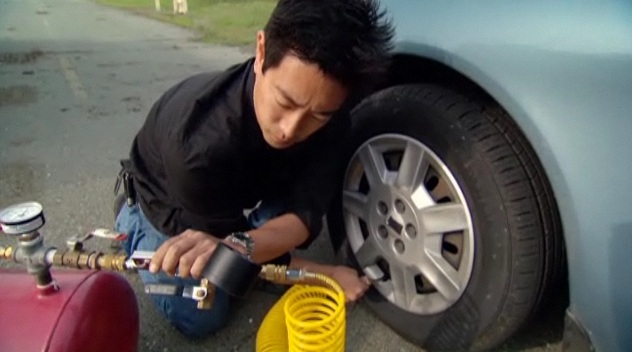
Results: With tires at 10 psi, the car used 3.7% more fuel than the control (tires at 35 psi). At 30 psi, the car used 1.2% more fuel than the control. At 40 psi, the car used 6.2% less fuel than the control and it used 7.6% less fuel with tires inflated to 60 psi.
Conclusion: Myth confirmed, although extreme measures are not recommended. Keeping tires inflated to their recommended pressure is definitely a good idea, since the car gets better gas mileage than with under-inflated tires. However, although the car got even better gas mileage when the tires were over-inflated, this is not a good idea for safety reasons and because it causes the tires to wear unevenly.
Mini-Myth #3: News stories of a laptop, a hair weave, and a refrigerator door stopping bullets are accurate and plausible.
Mythbusters: Kari, Grant, and Tory
Procedure:
- Study the three viewer-submitted news stories and note the details of each situation, including supposed bullet-stopping material, weapon used, and range.
- Gather bullet-stopping items, guns, ammo, ballistics gel, and safety accessories and take them to the gun range.
- Fire bird shot from a 12-gauge shotgun at a leather briefcase containing a laptop at close range (3-4 feet).
- Fire a bullet from a 40-caliber handgun at a ballistics gel head wearing a wig with hair extensions sitting in the driver’s seat of a car, 8-10 feet away from the shooter and positioned so that the bullet must travel through the back window and headrest of the car before hitting the target.
- Fire a bullet from a 9mm handgun at a refrigerator door filled with bottles of mustard and jars of miscellaneous condiments. Repeat the test with an old-fashioned refrigerator as well.
- Analyze the results.
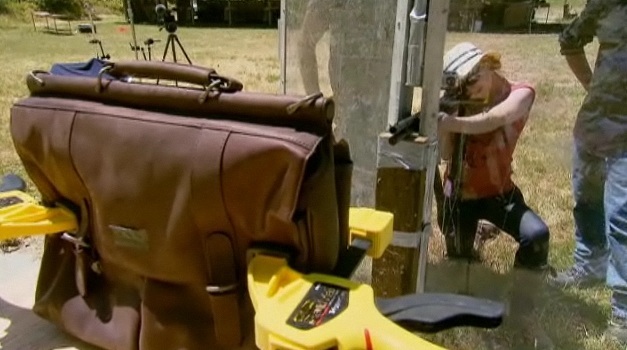
Results:
- Laptop – On the first try, the bird shot went straight through the laptop and briefcase and into the block of ballistics gel behind them. A second shot was aimed specifically at the laptop’s battery, and this time the battery stopped it, preventing it from going through the other side of the briefcase and into the ballistics gel.
- Hair Weave – The bullet went through the back window of the car, the headrest, the hair weave, and the ballistics gel head. Part of the weave was pulled into the ballistics gel by the bullet as it went through.
- Refrigerator Door – Several bullets went through the door and into the ballistics gel, along with plastic and glass shrapnel from the door itself and the condiment containers on the door. Similar damage resulted when firing at the door of an old-fashioned refrigerator made with more steel than modern refrigerators.
Conclusion: Stopping a bullet with a laptop is plausible. Stopping a bullet with a hair weave is busted. In the news story at issue here, the driver with the hair extensions did find a bullet in her weave after the shooting, but the team concluded that this had to be a bullet that had landed there after ricocheting around the car. Stopping a bullet with a refrigerator door is also busted, so find another place to hide the next time there is a shoot-out in your kitchen.
Mini-Myth #4: Covering a sneeze is the best way to prevent the spread of germs.
Mythbusters: Adam and Jamie
Procedure:
- Mark a series of arcs on a piece of white paper laid on the floor and label the distance of each arc from the sneezer’s position.
- While standing at the designated point at the edge of the marked paper, fill mouth with food coloring and take a pinch of snuff to induce sneezing.
- Sneeze three times into a hand, then count the number of colored droplets on the paper and note the distance of the farthest droplet.
- Repeat step 3, sneezing into elbow instead of hand.
- Repeat step 3, sneezing into a cloth handkerchief.
- Analyze the results.

Results: When Adam sneezed into his hand, more than 100 colored drops were counted, the farthest at a distance of 9.5 feet from where he was standing. No food coloring was observed on his clothing, but a lot ended up on his hand. When Jamie sneezed into his elbow, the food coloring was virtually contained and only stained that area of his suit — only two spots were found on the floor no farther than 6 inches away from where he was standing. No food coloring was found on his hand, either. When Adam sneezed into a handkerchief, the food coloring ended up primarily on the handkerchief, but it did bleed through the cloth and got on Adam’s hand as well. Four spots were counted on the floor, no farther than 6 inches away.
Conclusion: This was actually an experiment to see which sneeze-covering technique is the most effective at stopping the spread of germs rather than a myth to be confirmed or busted. Sneezing into your elbow is the best way to contain the germ-carrying droplets of saliva, both because it prevents the spread of the droplets (something which the hand did not do at all, as shown by the high-speed camera footage) and more importantly because it keeps the germs off of the hands and prevents them from being spread by shaking hands and touching things.
Mini-Myth #5: Taking candy away from a baby is very easy, hence the saying “as easy as taking candy from a baby.”
Mythbusters: Adam and Jamie
Procedure:
- Create a mechanical device that will take candy from a baby while measuring the amount of force required to get the candy out of the baby’s grip.
- Place a lollipop on a doll sitting in the test subject stroller and measure the amount of force needed to pick up the lollipop when no resistance is present (control).
- Place a child in the seat and hand him or her a lollipop. Use the candy-taking device to take the lollipop from the baby. Record the amount of force shown on the device’s force gauge.
- Repeat the test with several other children of varying ages between 6 and 18 months.
- Analyze the results.
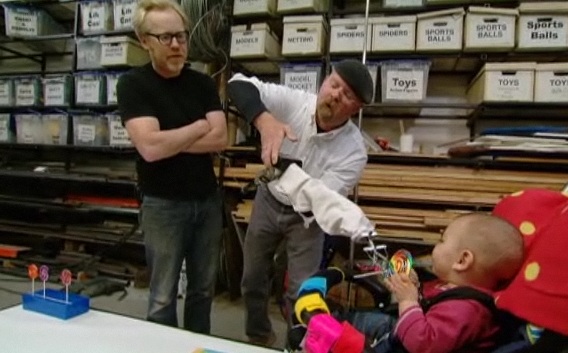
Results: The force gauge on the candy-taker registered .08 pounds of force required to pick up the candy with no resistance. Six-month-old Cole required the greatest force to pry the candy from his sticky little fingers, at 3.16 lbs. Two other children, one 14 months old and the other 18 months old, required 1.08 lbs. and 1.79 lbs. respectively.
Conclusion: Based solely on grip strength, which is what the mechanical candy-taker was measuring, the average force required to take the candy, about 2 lbs., was 25 times greater than the force required simply to pick the candy up, which Adam and Jamie determined to mean that the myth was busted. However, the babies also exhibited behaviors such as evasion (moving the candy away from Jamie’s device) and crying (attempting to make the adult feel guilty about trying to take the candy) which, added to grip strength, made it very difficult to take the candy away from them and provided added evidence for the “busted” proclamation.
Mini-Myth #6: After leaving a bottle of beer in the freezer for about two hours, hitting the bottle (either on a counter, with your hand, or with another bottle) will cause the beer to freeze immediately.
Mythbusters: Kari, Grant, and Tory
Procedure:
- Put four bottles of beer into a freezer.
- After two hours, take one bottle out and place it on a surface. Measure its temperature using a thermal camera. Hit it to see if the liquid beer turns to ice. Record the results.
- 30 minutes from the time the first beer was removed from the fridge, remove the next bottle and repeat step 2 (2.5 hours freezing time).
- 15 minutes later, remove the third bottle and repeat step 2 (2 hours 45 minutes freezing time).
- 15 minutes later, repeat step 2 with the last bottle (3 hours freezing time).
- Analyze the results.
Results: Nothing happened with the first two beers, which were both well above the beer freezing point of approximately 32 degrees Fahrenheit. The third beer was right at the freezing point, but it still remained liquid when hit. The fourth beer had a temperature of 31 degrees and was still liquid until the team tapped the bottle, at which point the liquid turned to ice just as in the online video that they were testing.
Conclusion: Myth confirmed, although the validity of this trick was never in question. Of more interest to the Mythbusters was which of two explanations for the trick was the correct one. One theory was that the shock of hitting the bottle creates bubbles that, when the beer is already at or near the freezing point, cause the temperature to suddenly lower to the freezing point and turn the liquid to ice. The other theory states that the trick works because the beer is supercooled — cooled to a temperature below the freezing point but still liquid — and when the bottle is hit, the resulting bubbles act as nucleation sites upon which ice crystals can form. The fact that the third beer, which was at the freezing point, did not freeze when hit while the fourth one, which was below the freezing point, did freeze points to the second theory as being the correct one.
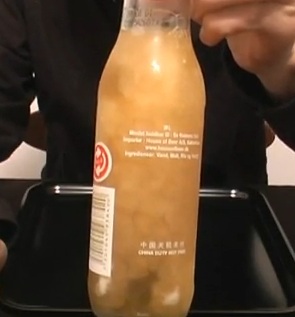
I enjoyed this episode, partly because they managed to cover so much ground in a short period of time, but also because there was such a wide variety of myths to test. Movie stunts, familiar sayings, guns, fuel efficiency, beer, party tricks, and good hygiene — they covered it all, and then some. Some results were surprising, especially the “spy wearing a tuxedo under his diving gear” myth, which Adam likened to a previous episode where they confirmed that elephants were in fact afraid of mice. Other experiments were not so much mythbusting as explaining things, but that was OK, too, and still very interesting. I particularly enjoyed seeing Jamie and Adam all dressed up (and I must say, that was the best Adam has looked in quite a while) and I was also amused to see Jamie’s mean side come out as he obviously took much pleasure in stealing candy from cute little babies with his scary mechanical arm. I also thought the sneezing myth was timely, since my father and I have been discussing and debating the merits of sneezing into one’s elbow for a while now.
The only downside this week was the lack of interesting behind-the-scenes material online at Discovery.com — if you don’t have time to check them out this week, don’t worry. The only high-speed camera footage was one clip of the bird shot fired at the laptop, and even the two “Combustion Chamber” after-show Q&A videos were lackluster. If you want to see episode-related video, you’re better off looking for clips of the frozen beer trick on YouTube — for once, they give us an experiment that we can try at home, which may just be the coolest part of all this week!
Rating: 5 / 5 Stars



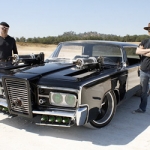
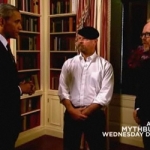
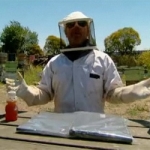

Pingback: mythbusters tests tyre pressure - Fuel Economy, Hypermiling, EcoModding News and Forum - EcoModder.com